
by Gwen Bortner | Marketing, Training & Instruction
Have you reached the upper limit of your productivity in your business? Are you doing all you can, but it still just doesn’t feel like you’ve grown your business to where you want it to be? If you’ve been running things as a CEO who is also the face of your business, there’s only so much growth you can handle on your own. If you’re ready to scale your business, it’s time to make some changes.
What’s Your Level-Up Goal?
The first step in scaling your business is to determine how far you want to take it. You don’t have to scale from where you are today to Amazon-like levels in the next calendar year. You get to determine how far you want your business to go, how big you want it to get, or how much income you want to earn from it. Nobody else can tell you what this goal should be; that privilege is all yours.
Once you have determined what the “next level” of business looks like for you, it’s also time to consider how much you’re willing to change. If you’re doing all you can right now and it isn’t enough to grow your business to the desired level, then something has to be different if you’re going to get over this plateau.
Here are three options for you to consider as potential scale models for your business:
Option 1: Hire More People
One of the easiest changes you can make to scale your business is to clear your own plate of everything that isn’t 100% necessary and essential for you to do. If you ARE the product or service you’re offering your clients, then you need to focus your energy on only the tasks that directly involve providing that product or service. You should spend all of your time consulting, coaching, or teaching – then hire someone else (or several people, more likely) to do everything else. This is an option to scale your business without really having to change anything about the offering; all the changes happen behind the scenes, where your clients and customers won’t even realize they’re occurring.
If you’ve done that and it still isn’t enough, then the other hiring option involves actually outsourcing some of your services to other people. You can bring on more coaches, consultants, or teachers and train them to provide the same services you’ve been providing. This way you can serve more clients and keep the same offering without having to work 70 hours a week to do it. If you go with this option, you may have to change your sales pages and product names to make it clear that not every client will be working with you directly.
Option 2: Change Your Offering
If you’re not comfortable hiring other people to work with your clients, another option is to change the product or service you’re offering. If you’ve been providing 1-on-1 services or custom solutions to every client, you can grow by changing those parameters. Instead of 1-on-1, offer group coaching sessions. If you have already been working with groups, consider booking larger venues or combining more than one group into the same training. This way you can deliver the same information to a larger group of people at once and make more money for each session that you offer.
Another idea is that Instead of delivering your services in person, you can offer them online. Either film yourself and create a free-standing product (like an online class or a self-paced workshop), or still do real-time events but cut down on your travel time and expenses by offering them via Zoom instead of face-to-face.
Option 3: The Best of Both
The third option is to combine options one and two to find the solution that works best for your business. You could hire people to conduct online services while you still travel and offer them in-person for a higher rate. You could let your clients start off by working with an associate, and then they can “graduate” to a higher level and work with you at a higher price point. You could convert your offerings to self-paced, online courses and sell those at a lower price point while still offering in-person, live events for folks who prefer that option and are willing to pay more for it.
Which One is Right for You?
The right solution is the one that feels the most right for you and your business. If one of these options scares you, that doesn’t necessarily make it the wrong one; it may be that it’s time to take a deep breath and take that plunge. On the other hand, if one of these options feels like it isn’t authentic for your business, then that one is definitely wrong. One of the best parts of running your own company is that YOU get to decide what is right for you and your business, and set your goals accordingly.
If you’d like some help figuring out how to scale your business, or which scaling method is best for you, click here to book a call with me. I’d love to help!

by Gwen Bortner | Leadership, Marketing, Operations
Recently I wrote an article for APeeling Magazine about how to get out of your head when you’re faced with an important decision. Today I’m sharing some similar ideas, but if you’d like to read the original article, click here.
I’ll bet if I asked you to track all the decisions you make in any given week, the number would easily be in the double digits. And that isn’t counting all simple, mundane decisions we make every day. As the CEO of a company, some of the decisions you make are small and simple – there’s an obviously right choice, and it only takes a few minutes of your time. However, there are also those other decisions, the ones that carry more weight or don’t have an obviously right answer, that tend to suck away all of your time and energy for longer than you’d like. If you’ve ever been lost in the weeds of making an important decision, today’s post is for you.
Chances are your decision-making struggle is caused by one or more of the following scenarios:
Outside Pressure
In this situation, you’re struggling to make a decision based on what other people think you should be doing, or your perception of what others will think. If there’s outside pressure pushing you in a certain direction, but your inner voice is telling you that’s not the right solution, it causes conflict. How much easier would life be if we could reject the idea of outside pressure, and just make decisions based on trusting our gut or knowing what we want? Unfortunately, most of us do struggle to meet outside expectations, so this can be a very real problem.
Want vs. Should
You may be struggling because there’s something you know you should do, but you really don’t want to do it. Or vice versa – there’s something you want to do, but it feels like something you shouldn’t be spending your time on. This might be a “suck it up” moment where you really just have to bite the bullet and do the unpleasant thing, even if it isn’t fun or exciting.
Feelings vs. Facts
In this scenario, chances are you know what you need to do, but you’re afraid of hurting someone else’s feelings by making this choice. A similar situation is one where you don’t want to have to inconvenience anyone else to make this decision possible, so you’re afraid to ask them for help. It might help to think about what you’re losing by not making this choice, or what you would lose if you didn’t ask for the help. It can help to have data to help you make the choice that will involve a difficult conversation.
Equal Footing
Sometimes a decision is really hard because it’s either a decision between two good choices or between two bad choices. If you can only choose one thing out of two great options, it can be hard to pick one because you’ve got a fear of missing out on the other option. Conversely, if you’re stuck between a rock and a hard place, neither option feels very appealing. In this case, you probably have to go with what feels the most right (or the least wrong), and just move on.
Alignment with Your Goals
Maybe what’s holding you back from making a decision is that somewhere, your gut is telling you that this decision isn’t really in line with what you need to be working on right now. If you’ve been following a system of setting goals in your business, is this decision going to bring you closer to your current goal, or distract you from it? If you’ve been feeling reluctant but you aren’t sure why, check in with yourself and your goals to see if this decision is truly in alignment with where you should be focusing right now.
Usually, the things that hold you back from making a quick decision are somewhat intertwined. Chances are, you’re actually dealing with more than one of these scenarios at once. The biggest obstacle is identifying what holds you back; once you can do that, it becomes a lot easier to find a solution and move forward.
The next time you’re stuck in the middle of a choice that’s too difficult for you, try identifying what’s holding you back and acknowledging the problem first. Then, make a list of your options so that you can evaluate them and pick the one that’s best for you. As the CEO of your company, you have to hold yourself accountable to making the best decisions that you can, given the tools and resources at your disposal. It isn’t always easy or fun, but it’s necessary if you want to keep moving forward in your business.
If you need some help identifying the greatest area of need in your business, the GEARS assessment can help! Click here to take this free assessment to determine the strengths and weaknesses in your business, so that you can choose the best options to focus your time and energy on for the upcoming quarter.
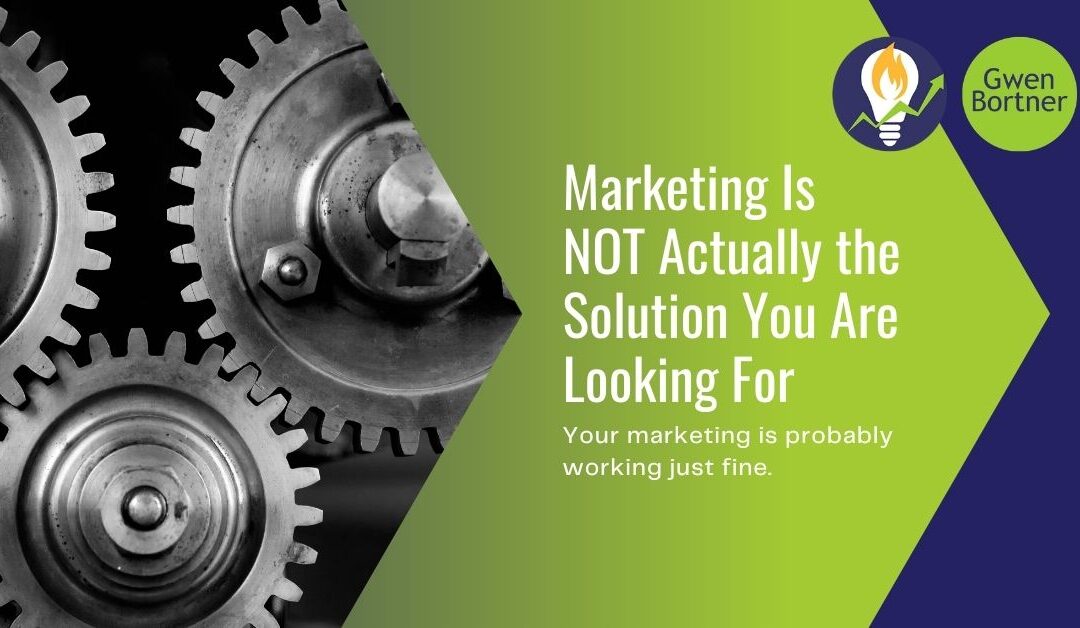
by Gwen Bortner | Marketing, Operations
As a successful entrepreneur and small business owner/CEO I know a few things about you:
- You are passionate about your business idea and the products and/or services you offer.
- You are most likely a visionary — with lots of ideas and the ability to see the amazing possibilities.
- Marketing and/or sales either comes naturally and has been your primary focus as you have created, developed, and grown your business.
All of these are excellent traits for an entrepreneur to possess and fundamentally are a key component to your success thus far. But in almost every small business there is an inflection point.
This point of inflection is fairly easy to identify for the owner as they start feeling stuck.
Stuck at a particular income level instead of consistently growing.
Stuck doing the same “boring” tasks instead of working in their zone of genius.
Stuck carrying all the burden of the business instead of enjoying the elusive entrepreneurial freedom so often touted.
Feeling stuck is your business trying to tell you that something is wrong (or maybe several somethings).
When most entrepreneurs feel stuck, their go-to solution is marketing. More ads, more posts, more offers. New tactics, new products, new programs. But, it is rare that the business’ marketing is actually the problem. So marketing will rarely help and in some cases will actually make things worse.
Instead it is time to look at the business’ operations.
I use the acronym GEARS for the parts of your business’ operations:
- Goods – Products and services you sell
- Effectiveness – Personal and team productivity, business leadership
- Accountability – Prioritizing what is important and taking consistent action to reach goals
- Resources – People, money, equipment, technology, and similar
- Systems – Processes, routines, and reporting
Most entrepreneurs are not operationally inclined; it is counter to their visionary gifts. So operations get overlooked or put on the back burner until an issue becomes critical. And then it gets addressed quickly, in a “make do” manner without lots of consideration for longer term effectiveness.
At the point of “stuck”, all of the patches, quick-fixes, and band-aids are no longer serving the business and the internal gears of your business are about to break. Your business has hit its operational capacity limit.
Unfortunately, what got you here (stuck), will rarely get you there (unstuck).
If you are feeling stuck and not sure where to start, sign up below to download your GEARS self-assessment, or click here to learn more. In just a few minutes you will identify which GEARS need to be addressed and how to prioritize your efforts for maximum benefit. Optimize your GEARS and you will be unstuck and moving forward before you know it!
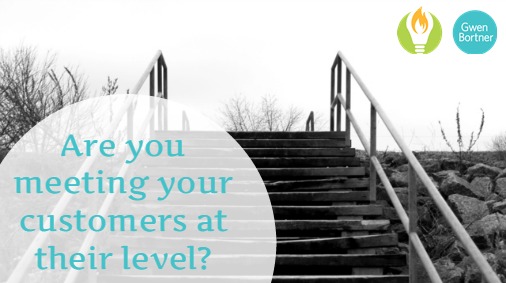
by Gwen Bortner | Marketing
A lot of entrepreneurs are in the problem-solving business: we help people do the things that will make life better. We solve the problems they know they have and sometimes, the problems they don’t. Are you helping your customers solve the problems they know about, or are you trying too soon to fix a problem they don’t know they have?
You understand that your product or service can solve someone’s problem. The question is: does your customer understand that, too? You can’t fix someone’s problem for them if they don’t know they have it. (A quick and easy example: I’m not currently in the market for termite services, but if you came to my house and showed me proof of termite damage, I’d suddenly BE in the market for those services. You’ve got to help me see the problem before I’m willing to pay for the solution.)
There are five basic levels of awareness that your customers have when it comes to their problems. Your job is to meet them at their current level and help them move toward the higher ones. I’ll use the example of a brick and mortar shop owner without a website as our sample customer.
Level 1: Ignorance isn’t Bliss
At this stage, your customer doesn’t know there’s a problem, at all. He’s a local toy store owner who is making occasional sales from customers who walk in off the street, and he thinks that’s pretty good! What more does he need? Nothing, as far as he’s concerned.
Level 2: Tip of the Iceberg
At this stage, your customer knows he has a problem, but has NO idea how to fix it. He probably thinks something like, “I’m not making enough sales to keep paying my rent on this shop.” So he realizes that he should be making more sales, but he isn’t sure how to go about doing that.
Level 3: Basic Awareness
At this stage, your customer knows that there might be options out there to solve his problem. He has seen other business owners employ sign wavers outside their shops, and he thinks maybe he should do that. He has also considered that maybe he needs a website like the store owner next door. He knows he has options, but he can’t connect those options to specific goals or results.
Level 4: Moving toward Choice
At this stage, your customer knows that if he had a website he could probably make more sales, but he isn’t sure the best way to do that. Should he hire someone to build it for him, or attempt a DIY solution? The choices are overwhelming, even though he already has an idea of a path to pursue.
Level 5: Solution-Ready
At this stage, your customer knows that he needs a website, and that you’re the best person to build it for him. He has already done research and has followed you on social media or visited your website so that he understands the credibility you bring to the table. At this stage he is ready to buy, and all you have to do is offer him something to purchase.
When you create a piece of content, like a blog post or email newsletter, you need to first think about the level of awareness your prospective customer has when he’s reading that content. Write the content to move him from one level up to the next, so that you can guide him on the path that will eventually lead to buying from you.
When you’re building your website or other platform, you should have content that appeals to your audience at the first four levels, because you never know someone’s level of awareness when they first come into contact with your work. As you grow your business, you can build sales funnels that start at each level (1-4), and move the customer up to level 5 with carefully crafted content.
Need a reminder? Download this free graphic to help you remember to move your audience through the levels! Just click on the image to save it to your computer:
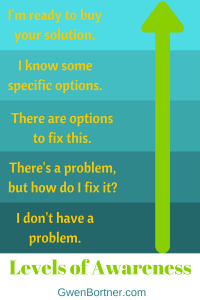
Are most of your customers coming to you at one specific level? How can you create content that will help them advance to the next one?
If you’d like to improve YOUR content marketing and speak to people at all levels of awareness, join us in June as we read Epic Content Marketing in the Small Biz Book Club! Throughout the month you’ll learn how to create content that meets your customers where they are and moves them through your sales cycle. Sign up below to join us in the club!
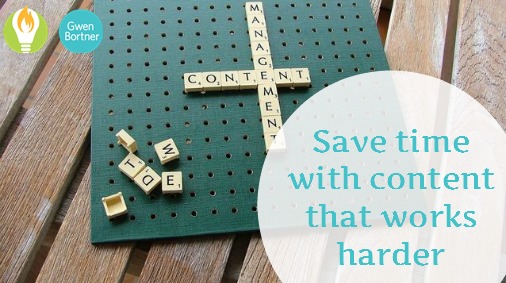
by Gwen Bortner | Marketing, Tips & Tricks
If you’re not a writer by trade, chances are good that when you think about creating quality content for your audience, you start to worry about how much time that’s going to take. While it should take some time to create quality content, the key is to maximize the time you’re spending and get the most out of the content, to make it worth the time it cost you.
Defining Content
For our purposes, the term “content” means,”any educational, entertaining, or inspiring piece of information you put out into the world for consumption by your audience.” A single piece of content could be one page or a 2-minute video, but it could also be a 300-page book or a week-long online course. The first step in maximizing the time you spend creating content is to understand that you don’t always have to go for the longer end of that spectrum; shorter pieces of content are more likely to hook your audience and keep their interest all the way through.
Types of Content
Content comes in as many forms as there are ways to communicate – written word, audio, video, and visual images all make up the spectrum of content formatting. The main types of content you can harness for your business include:
- newsletters/e-mail
- blog posts or website pages
- opt-ins (lead magnets)
- nontraditional content*
- paid content
If you learn how to make these different types of content work together, that’s the key to maximizing your time.
Tips for Maximizing Content
Create ONE main piece of content, and use it in a variety of ways to get the most out of it. For instance:
Scenario A: Maximizing Paid Content
Create a piece of paid content, such as an e-book or online course.
Now take one small section of that content (maybe a resource guide, or the first chapter or lesson) and make it into a lead magnet to get people on your email list.
Create a list of questions people have about this product before they buy, and turn each one of those questions into a blog post.
Take the most common question and turn it into a newsletter topic, really digging deep into your customers’ questions and explaining to them how this product can solve their problems. Then link to the blog posts you created to help answer other questions they may have.
Scenario B: Maximizing Free Content
Think about one big goal your customers have; now, create a series of regular, ongoing content to help them achieve that goal.*
Post this content series on your blog, for free.
In your regular newsletter, talk about the goals your customers have, and then let them know you’ve created this free content to help them achieve those goals.
Make an add-on resource to your free content, such as a workbook or a bonus video, and turn that into your lead magnet for your email list.
Create paid products or services that supplement the process of goal-reaching, for customers who want to go beyond the depth of the free content.
*Ideas for Nontraditional, Free Content:
- an audio or video podcast that breaks down the topic into easily-completed steps
- a social media challenge, such as posting a photo every day to Instagram
- a “mini course” or workshop with one new lesson each day for a week, month, etc.
- a book club, where members can come together to study topics that are interesting to them (Sound familiar?)
- a private online group (like a Facebook group or membership site) where they can come together to discuss their goals with people who are working on similar goals
- a _____-along (read-along, knit-along, quilt-along, de-clutter-along, etc.) – where everyone is doing basically the same thing at the same time and encouraging one another along the way
When you take the time to really plan out your content with a purpose, it becomes easier to see how you can present one piece of content in multiple formats to maximize the time you spent on it AND bring a cohesive theme to your online platforms.
Would you like to work on creating content that establishes you as an authority in your niche and lets you connect with your customers and earn their trust? Join us in June as we study Epic Content Marketing for the Small Biz Book Club!
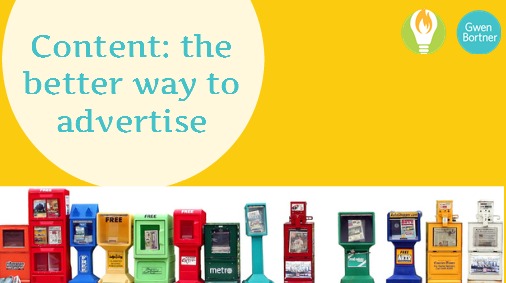
by Gwen Bortner | Abundance, Marketing
One of the things I love most about reading business books is that I don’t always have to invent brand-new ideas for my business; instead, I can find great ideas in the pages of these books. Starting in April, I’ll be leading a book study of Brandscaping by Andrew M. Davis for the Small Biz Book Club, so today I wanted to share an example of how this book gave me a great idea.
Of course, you already know that I got the idea for the entire book club from Brandscaping, but that wasn’t the only gem I found when I read it. I was actually able to get an idea to help one of my consulting clients, too! Here’s how:
Advertising: Worth it or not?
My client and I were discussing an opportunity she had to advertise in a local community magazine (this client runs a brick and mortar craft supply shop). The advertising cost was somewhat steep, but she felt it might help her generate some local business for her shop. After all, that is often our go-to place to drum up business, right? Advertising. However, that doesn’t mean it’s always the best option.
Since I had read Brandscaping, I knew that advertising only gets you so far: a little bit of exposure in a single publication. Let’s be honest – how often do you actually read the ads in a magazine, instead of just skimming over them to get to the content?
Don’t advertise – Brandscape
With that in mind, I suggested to my client that instead of paying for an ad, she pitch herself to the magazine editor as a prospective contributor.
I told my client that she could write regular articles for this publication, centered around a topic that would be of interest to the local readers and help to promote her shop. (In this case, the topic was home decor tips using handmade projects, for which the readers could come to her shop to purchase supplies.) This is a win-win scenario, because the magazine editor gets regular, fresh content for her publication and the shop owner gets free advertising (heck, the magazine might even pay her to write the pieces!).
Share the Love
I told my client that if she was worried about generating enough content for regular publication, she could extend the “brandscape” even further by inviting a few other shop owners to contribute to the column as well. They could team up and divide the work so no one would have to find the time and inspiration to write one article every time the magazine was published. As long as she chose shop owners who could also write about the general topic without directly competing with her for business, this would be a great way to take some of the pressure off of her and add a few more networking relationships with other small business owners.
If I hadn’t read Brandscaping, I never would have had this idea. What will be the next great idea YOU have for your business? Will you find it in a book?
If you’d like to read Brandscaping and get a FREE weekly study guide to help you stay on track and apply the material to your small business, sign up below to be notified when the study guide goes live. It’s entirely free, and I hope to see you in the club!









